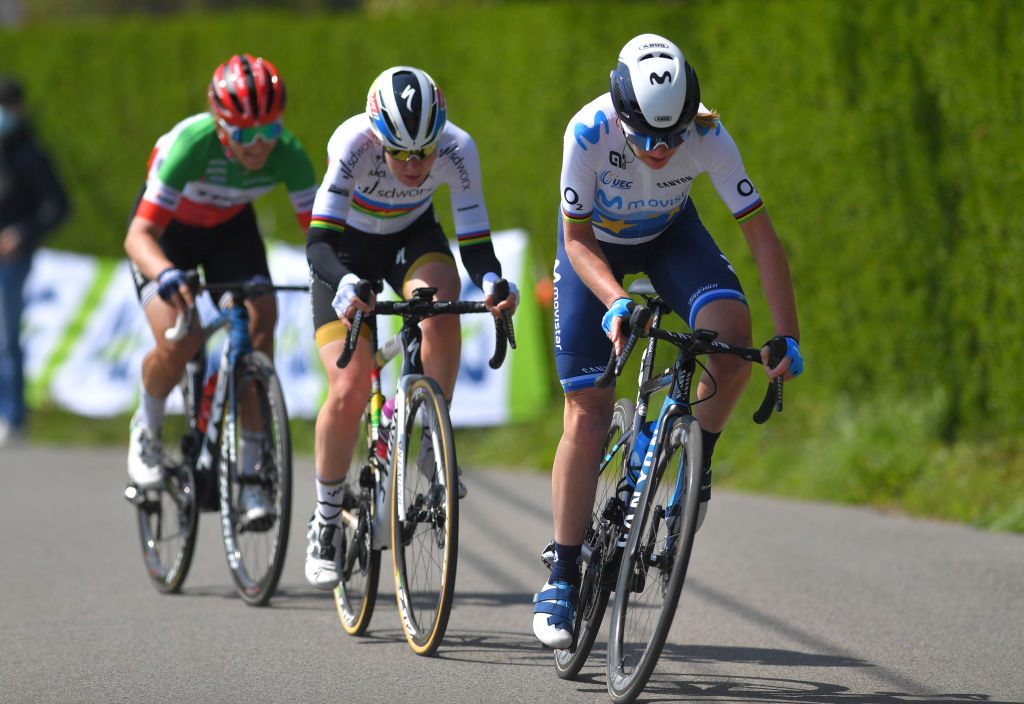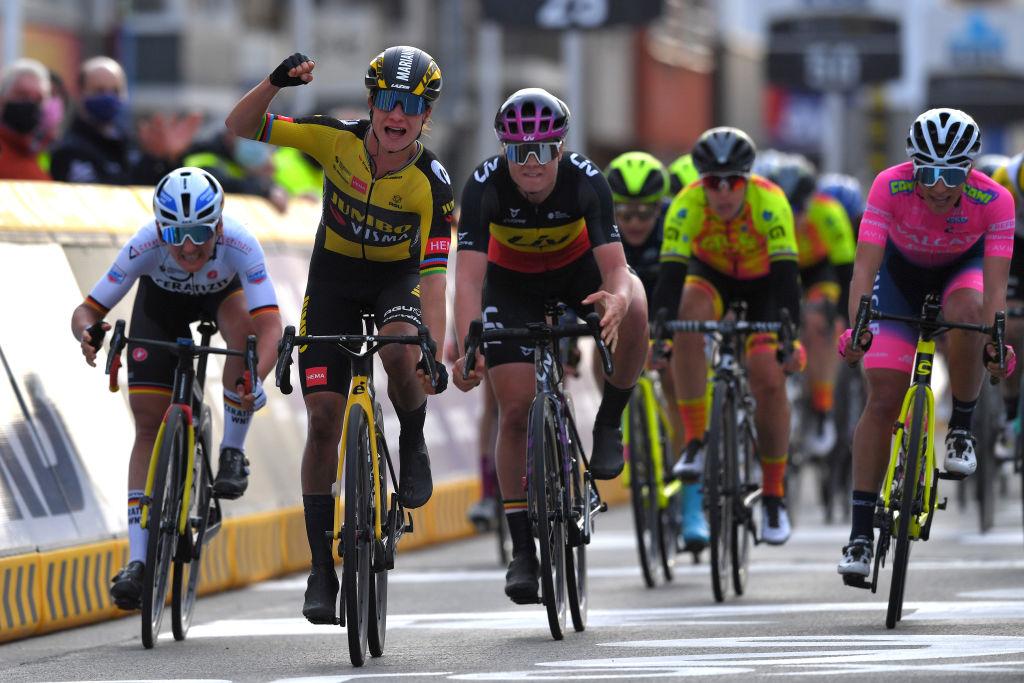Women’s WorldTeam average salary grows but peloton wage gap widens
25 per cent salary and 22 per cent team budget growth for top-tier teams, according to audit

The UCI has revealed that the average salary of athletes contracted with Women's WorldTeams has increased by 25 per cent in the one year following the implementation of a minimum wage required for top-tier teams, according to a report by the auditing firm EY Lausanne.
The external auditor was appointed by the UCI as part of the teams' registration for the 2020 and 2021 seasons, and its report also showed that the average budget of Women’s WorldTeams increased by 22 per cent between 2020 and 2021.
There are currently nine Women’s WorldTeams; Alé BTC Ljubljana, Canyon-SRAM, FDJ Nouvelle-Aquitaine Futuroscope, Liv Racing, Movistar Team Women, Team BikeExchange, Team DSM, Team SD Worx and Trek-Segafredo.
“The rise in UCI Women’s WorldTeams salaries and budgets shows that the reform of professional women’s road cycling, as set out in cycling’s Agenda 2022, is having a positive impact on women riders and their teams,” said UCI President David Lappartient.
“There is still work to be done to strengthen the sector and continue to develop it, but the creation of the UCI Women's WorldTeams, four years after the creation of the UCI Women's WorldTour, is a central element for the growth of women's cycling.”
The Women’s WorldTour launched in 2016 and replaced the former World Cup one-day race series in an effort to streamline and bolster the top women’s one-day and stage races on the international calendar.
The women's peloton then underwent new reforms that officially came into effect in January 2020 with the launch of a new two-tier team system - WorldTeams and Continental Teams. WorldTeam status comes with increased financial requirements such as a multi-year sponsorship guarantee, a minimum salary for contracted riders, along with social insurances and benefits such as maternity leave.
Get The Leadout Newsletter
The latest race content, interviews, features, reviews and expert buying guides, direct to your inbox!
The minimum salary requirements rose to €20,000 this year and will equal the second-tier men's ProTeams, currently set at €32,100, by 2023. In addition to these requirements, there will be an obligation to contribute to a pension plan from the 2022 season, which was confirmed by the UCI.
The UCI stated that the creation of a minimum salary is closing the gap between the average salaries paid to Women’s WorldTeams riders and members of the men’s UCI ProTeams, reducing the gap from 67.53 per cent to 44.21 per cent this year.
Part of that gap reduction can also be attributed to Trek-Segafredo’s and Team BikeExchange’s decision to raise the minimum salary of riders on its Women’s WorldTour squad to match the rate mandated for the top-tier WorldTour riders on its men’s squad - effectively doubling their women's minimum wage from €20,000 to €40,045.
"Salary really depends on the individual but we can confirm that all of our professional road cycling athletes—regardless of gender—make at or above the minimum for the men’s program," Eric Bjorling, Director of Brand Marketing at Trek Bikes, told Cyclingnews.
"There’s been some talk that pro cycling might require raising the Women’s WorldTour minimum to the same as the men’s and this is something we strongly support. That said, we didn’t want to wait for a mandate, so we made the decision to do this on our own in the fall of 2020. It went into effect January 1, 2021."

Wage disparity gap on the rise
There are 52 second-tier Continental Teams that contract upwards of 600 female athletes racing on the international calendar, and many of these teams compete in the Women's WorldTour events.
Second-tier teams are not required to pay a minimum wage to their athletes, and although some do, many do not. The EY Lausanne audit report did not include the second-tier teams and there was no information released by the UCI about their salary ranges or statistics.
In the report by EY Lausanne, the average wage gap was based on a comparative median salary basis, for example, without the extreme salary levels.
Cyclingnews reported that few female athletes earn above €100,000, which would be considered on the extreme end of a salary range.
In addition, there's a large gap between the budgets of Women's WorldTeam and Continental Teams. The average top-tier team could have a budget between €1 million and €3 million annually, while a second-tier team is more likely to run on between €100,000 and €500,000.
The Cyclists’ Alliance (TCA) warned that the while the wage gap between the average salaries of the Women’s WorldTeams and the men’s ProTeam is closing, the gap between the highest paid and lowest paid athletes from all top-tier and second-tier women’s teams is growing.
"Based on our 2020 Annual rider survey the wage disparity gap is growing. We hope to publish our 2021 results soon to see if the wage disparity gap has increased further or decreased," TCA wrote in a post on Twitter on Thursday.
TCA released the results from its annual survey at the end of last year, and the findings revealed that the wage disparity grew between the highest and lowest paid riders in the women's peloton.
The survey revealed that the number of female professional riders receiving zero salary increased from 17 per cent in 2019 to 25 per cent in 2020.
In addition, there were 43 per cent of riders, who were surveyed, who reimbursed their team for one or more of the following; equipment, mechanical service, medical costs and travel costs in 2020. Also, 33 per cent of riders surveyed work a second job while racing professionally.
That TCA survey was open to all cycling disciplines as well as under-23, Continental and Women's WorldTour levels to ensure the results were representative of the landscape of women's professional cycling on a whole. Over 100 riders responded to the survey.

Kirsten Frattini is the Deputy Editor of Cyclingnews, overseeing the global racing content plan.
Kirsten has a background in Kinesiology and Health Science. She has been involved in cycling from the community and grassroots level to professional cycling's biggest races, reporting on the WorldTour, Spring Classics, Tours de France, World Championships and Olympic Games.
She began her sports journalism career with Cyclingnews as a North American Correspondent in 2006. In 2018, Kirsten became Women's Editor – overseeing the content strategy, race coverage and growth of women's professional cycling – before becoming Deputy Editor in 2023.